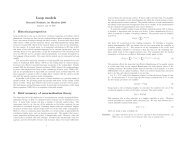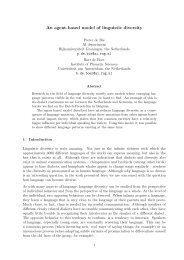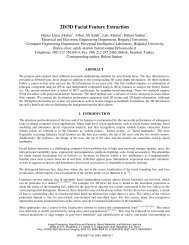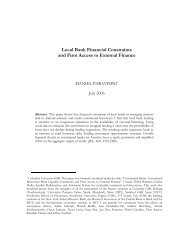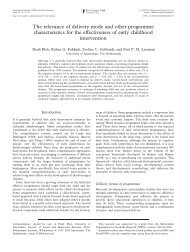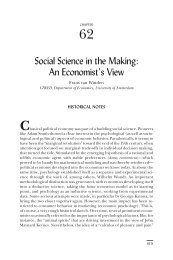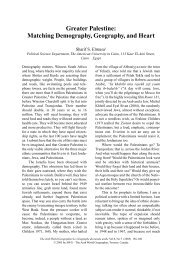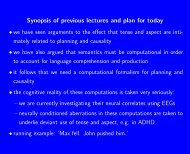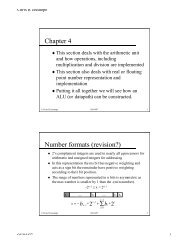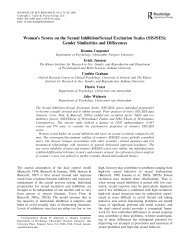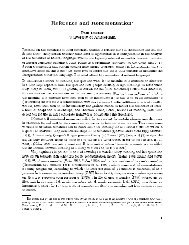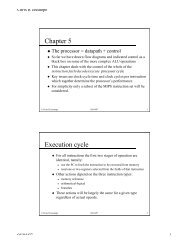Social closure among the higher educated: trends in educational ...
Social closure among the higher educated: trends in educational ...
Social closure among the higher educated: trends in educational ...
You also want an ePaper? Increase the reach of your titles
YUMPU automatically turns print PDFs into web optimized ePapers that Google loves.
1<strong>Social</strong> <strong>closure</strong> <strong>among</strong> <strong>the</strong> <strong>higher</strong> <strong>educated</strong>: <strong>trends</strong> <strong>in</strong> <strong>educational</strong> homogamy<strong>in</strong> 55 countriesJeroen Smits(http://home.planet.nl/~smits.jeroen)AbstractIn this paper, logl<strong>in</strong>ear analysis is used to assess for 55 countries - and for two age groups with<strong>in</strong><strong>the</strong>se countries - <strong>the</strong> degree of <strong>educational</strong> homogamy <strong>among</strong> persons with a high <strong>educational</strong> level.These analyses are conducted to ga<strong>in</strong> <strong>in</strong>sight <strong>in</strong> (<strong>the</strong> factors that affect) <strong>the</strong> strength of <strong>the</strong> tendencytowards social <strong>closure</strong> <strong>among</strong> <strong>the</strong> <strong>educational</strong> elite of <strong>the</strong> countries. In all 55 countries, <strong>the</strong> <strong>higher</strong><strong>educated</strong> tend to marry with<strong>in</strong> <strong>the</strong>ir own group. However, <strong>the</strong> strength of this tendency differsconsiderably <strong>among</strong> <strong>the</strong> countries. These differences are expla<strong>in</strong>ed <strong>in</strong> terms of <strong>the</strong> level of economicdevelopment, <strong>the</strong> dom<strong>in</strong>ant religion, and <strong>the</strong> size of <strong>the</strong> group of <strong>higher</strong> <strong>educated</strong>. In countries with<strong>higher</strong> levels of economic development, <strong>in</strong> Protestant countries, and <strong>in</strong> countries with more personswith a high <strong>educational</strong> level, <strong>the</strong> tendency <strong>among</strong> <strong>the</strong> <strong>higher</strong> <strong>educated</strong> to marry with<strong>in</strong> <strong>the</strong> own groupis lower than elsewhere. Besides differences <strong>among</strong> countries, <strong>trends</strong> with<strong>in</strong> countries are studied,too. The results of this analysis <strong>in</strong>dicate that <strong>in</strong> <strong>the</strong> decades after World War II, <strong>the</strong> openness of <strong>the</strong><strong>educational</strong> elite has <strong>in</strong>creased <strong>in</strong> most of <strong>the</strong> countries.1. IntroductionThe study of <strong>in</strong>termarriage is a major source of <strong>in</strong>formation on <strong>the</strong> openness of <strong>the</strong> social structure ofsocieties (Glass 1954; Hout 1982; Ultee and Luijkx 1990). If <strong>the</strong>re are many marital ties between <strong>the</strong>members of different groups <strong>in</strong> a society, <strong>the</strong>re must also be o<strong>the</strong>r social contacts - like friendships -between <strong>the</strong>m. Fur<strong>the</strong>rmore, <strong>the</strong> children of different groups must have <strong>the</strong> opportunity to meet eacho<strong>the</strong>r -- at school, <strong>in</strong> <strong>the</strong> neighborhood, or dur<strong>in</strong>g leisure activities. Moreover, if <strong>in</strong>termarriage <strong>among</strong><strong>the</strong> members of different groups is a common phenomenon, this <strong>in</strong>dicates that <strong>the</strong> members of <strong>the</strong>segroups accept each o<strong>the</strong>r as social equals (Kalmijn 1998).In this paper <strong>the</strong> marriage behavior 1 of persons with a high <strong>educational</strong> level - and hence withgood prospects on <strong>the</strong> labor market - is studied for a large number of countries. A central objective of<strong>the</strong> research is to f<strong>in</strong>d out whe<strong>the</strong>r and to what extent persons with a high <strong>educational</strong> level tend toclose <strong>the</strong>mselves off from <strong>the</strong> rest of society. The “<strong>closure</strong> <strong>the</strong>sis” (Park<strong>in</strong> 1974; Goldthorpe 1980)poses that <strong>the</strong> privileged groups <strong>in</strong> a society will use <strong>the</strong>ir resources to protect <strong>the</strong>ir position and that<strong>the</strong>y will not let <strong>in</strong> more persons than are needed to fill up <strong>the</strong> open places. One of <strong>the</strong> ways <strong>in</strong> which<strong>the</strong>y accomplish this is by marry<strong>in</strong>g with<strong>in</strong> <strong>the</strong>ir own group (Weber [1921] 1972). This idea is supportedby many empirical studies, which show that marriage partners tend to resemble each o<strong>the</strong>r
2with regard to status characteristics like <strong>the</strong> social class of <strong>the</strong>ir parents (Blau and Duncan 1967;Kalmijn 1991; Uunk 1996), <strong>the</strong>ir <strong>educational</strong> level (Berent 1954; Rockwell 1976; Ultee and Luijkx1990) and - if both spouses are employed - <strong>the</strong>ir occupational level (Lipset and Bendix 1958; Hout1982; Smits, Ultee and Lammers 1999).The tendency to marry someone with <strong>the</strong> same <strong>educational</strong> level is called <strong>educational</strong> homogamy.In modern societies, this tendency is a very important form of social <strong>closure</strong>. In <strong>the</strong>se societies,education plays a major role <strong>in</strong> <strong>the</strong> distribution of <strong>in</strong>dividuals over social positions. In fact, it hasbecome very difficult to acquire a favorable social position without <strong>the</strong> required education (Blau andDuncan 1967; Treiman 1970; Hauser and Sewell 1986). In modern societies, <strong>the</strong> effect of socialbackground on occupational placement also runs to a large extent via <strong>the</strong> <strong>educational</strong> channel(Jencks et al. 1979; Treiman and Jip 1989). A high <strong>educational</strong> level, <strong>the</strong>refore, has become animportant prerequisite for social success.This is not only true for one’s own <strong>educational</strong> level; it also applies to <strong>the</strong> <strong>educational</strong> level ofone’s spouse. A spouse with a high <strong>educational</strong> level may contribute to one’s societal success <strong>in</strong>several ways. Obviously, such a spouse - if he or she is engaged <strong>in</strong> paid employment - will generallyearn more and hence contribute more to <strong>the</strong> family <strong>in</strong>come than a spouse with a lower <strong>educational</strong>level. But besides this direct advantage of <strong>the</strong> spouse’s <strong>educational</strong> level, <strong>the</strong>re are also some<strong>in</strong>direct advantages. It is common knowledge that married persons may profit from <strong>the</strong>ir partner’sresources. The classic example is <strong>the</strong> resourceful fa<strong>the</strong>r-<strong>in</strong>-law who helps his son/daughter-<strong>in</strong>-lawf<strong>in</strong>ancially or arranges a job for him/her. But <strong>the</strong> knowledge, skills, and social networks of <strong>the</strong>spouses <strong>the</strong>mselves are also important. Research on so-called spouse effects (Bernasco 1994) hasshown that <strong>in</strong>dividuals with a spouse who has a high <strong>educational</strong> level or a favorable labor marketposition tend to have a <strong>higher</strong> probability of be<strong>in</strong>g employed (Ultee, Dessens and Jansen 1988;Bernasco 1994) and to have <strong>higher</strong> occupational levels and earn<strong>in</strong>gs (e.g., Benham 1974; Kerckhoff1978; Smits, Ultee and Lammers 1996) than <strong>in</strong>dividuals whose spouse has a lower <strong>educational</strong> levelor a less favorable labor market position.Ano<strong>the</strong>r reason to study <strong>educational</strong> homogamy is that <strong>educational</strong> homogamy may be a majorsource of social <strong>in</strong>equality. If <strong>in</strong>dividuals with a high <strong>educational</strong> level tend to select spouses with high<strong>educational</strong> levels, <strong>in</strong>dividuals with less <strong>educational</strong> credentials have less choice. The only marriagecandidates left are those with lower <strong>educational</strong> levels. This may lead to a concentration of coupleswith two high <strong>educational</strong> levels at <strong>the</strong> upper end of society and a concentration of couples with twolow <strong>educational</strong> levels at <strong>the</strong> lower end of society. Thus, an unequal distribution of education over<strong>in</strong>dividuals may be transposed via <strong>the</strong>ir marriage behavior <strong>in</strong>to a larger <strong>in</strong>equality <strong>in</strong> <strong>the</strong> distribution ofeducation over couples (compare Ultee 1989; Bernasco 1994). The need for <strong>in</strong>sight <strong>in</strong> this processhas become urgent because of <strong>the</strong> sharp rise <strong>in</strong> <strong>the</strong> labor force participation of married women <strong>in</strong>recent decades <strong>in</strong> most countries of <strong>the</strong> world. If more married women with a high <strong>educational</strong> levelactually translate <strong>the</strong>ir education <strong>in</strong>to a high-level occupation, <strong>in</strong>come <strong>in</strong>equality <strong>among</strong> families might<strong>in</strong>crease (Björklund 1992). After all, if <strong>the</strong> number of hours worked <strong>in</strong> a week is <strong>the</strong> same, womenwho have had more education can be expected to earn more money than women with a lower<strong>educational</strong> level.Comparative researchBecause social <strong>closure</strong> <strong>among</strong> <strong>the</strong> <strong>higher</strong> <strong>educated</strong> may exacerbate social <strong>in</strong>equality, it is importantto understand <strong>the</strong> factors that <strong>in</strong>fluence <strong>educational</strong> homogamy <strong>among</strong> <strong>the</strong> members of this group.Comparative research can provide that <strong>in</strong>sight. In cross-national or cross-temporal research,
3differences <strong>in</strong> <strong>the</strong> degree of <strong>educational</strong> homogamy <strong>among</strong> countries and/or time periods can berelated to differences <strong>in</strong> o<strong>the</strong>r characteristics of <strong>the</strong> countries and/or time periods. This is <strong>the</strong>approach taken here.Large-scale cross-national research on <strong>educational</strong> homogamy was conducted earlier by Ulteeand Luijkx (1990) and by Smits, Ultee and Lammers (1998). These studies, which perta<strong>in</strong> to 23 and65 countries respectively, show that countries differ <strong>in</strong> <strong>the</strong>ir degree of <strong>educational</strong> homogamy. Theyalso show that <strong>the</strong>se differences are related to differences <strong>in</strong> <strong>the</strong> countries’ level of economicdevelopment, to <strong>the</strong>ir dom<strong>in</strong>ant religion, and - for <strong>the</strong> least developed countries - <strong>the</strong>ir technologicalbackground. When <strong>the</strong> level of economic development of <strong>the</strong> countries <strong>in</strong>creases, <strong>the</strong>ir degree of<strong>educational</strong> homogamy first <strong>in</strong>creases, <strong>the</strong>n reaches a peak, and subsequently decreases aga<strong>in</strong>.Fur<strong>the</strong>rmore, countries with a predom<strong>in</strong>antly Protestant population show less <strong>educational</strong> homogamythan predom<strong>in</strong>antly Catholic or Confucian countries and develop<strong>in</strong>g countries with a horticulturalbackground show less <strong>educational</strong> homogamy than develop<strong>in</strong>g countries with an agrarian background.These studies did not f<strong>in</strong>d any consistent relationship between <strong>the</strong> degree of politicaldemocracy and <strong>educational</strong> homogamy.To analyse <strong>the</strong> differences <strong>among</strong> countries <strong>in</strong> <strong>educational</strong> homogamy, both Ultee and Luijkxand Smits et al. used a ra<strong>the</strong>r general measure of <strong>educational</strong> homogamy, <strong>the</strong> logl<strong>in</strong>ear stepparameter, which <strong>in</strong>dicates <strong>the</strong> degree to which married persons <strong>in</strong> a country tend to have a spousewith a closely related <strong>educational</strong> level. This measure gives a good impression of <strong>the</strong> importance ofeducation <strong>in</strong> choos<strong>in</strong>g a partner for <strong>the</strong> vast majority of <strong>the</strong> population of a country, but it does notgive <strong>in</strong>sight <strong>in</strong> <strong>educational</strong> homogamy <strong>among</strong> specific <strong>educational</strong> groups. Therefore, <strong>the</strong>se studiesdo not shed light on <strong>the</strong> tendency towards social <strong>closure</strong> <strong>among</strong> <strong>the</strong> <strong>higher</strong> <strong>educated</strong>. 2A fur<strong>the</strong>r restriction of <strong>the</strong> work of Smits et al. is that <strong>the</strong>y test hypo<strong>the</strong>ses on <strong>the</strong> effect of level ofeconomic development on <strong>the</strong> basis of data for countries of different level of development at <strong>the</strong>same po<strong>in</strong>t <strong>in</strong> time. Their conclusions, <strong>the</strong>refore, depend on <strong>the</strong> key assumption that with <strong>in</strong>creas<strong>in</strong>glevel of development <strong>the</strong> pattern of <strong>educational</strong> homogamy changes <strong>in</strong> all countries <strong>in</strong> <strong>the</strong> same way.Because Smits et al. do not test <strong>the</strong> validity of this assumption, <strong>the</strong>ir conclusions with regard to <strong>the</strong>effects of level of economic development are tentative. To draw more def<strong>in</strong>itive conclusions, it isnecessary to study <strong>trends</strong> with<strong>in</strong> countries, us<strong>in</strong>g data for more po<strong>in</strong>ts <strong>in</strong> time or for different agegroups.In this paper, we follow <strong>the</strong> way set out by Smits et al. to study differences <strong>in</strong> <strong>educational</strong>homogamy <strong>among</strong> a large number of countries. However, <strong>in</strong>stead of us<strong>in</strong>g a general <strong>in</strong>dicator for<strong>educational</strong> homogamy <strong>among</strong> <strong>the</strong> vast majority of <strong>the</strong> population, we focus on <strong>the</strong> tendency towards<strong>educational</strong> assortative marriage of a more clearly def<strong>in</strong>ed <strong>educational</strong> group, which will be called <strong>the</strong>"<strong>higher</strong> <strong>educated</strong>". This group will be def<strong>in</strong>ed as persons who have at least completed secondaryeducation. In <strong>the</strong> most developed countries of <strong>the</strong> world, this group may not be very exclusive,because a ra<strong>the</strong>r large part of <strong>the</strong> population belongs to it. However, <strong>the</strong> countries which we studyalso <strong>in</strong>clude some of <strong>the</strong> least developed countries of <strong>the</strong> world, where <strong>the</strong> group of persons withcompleted secondary or <strong>higher</strong> education is very small and hence really forms an elite. By compar<strong>in</strong>g<strong>the</strong> tendency towards <strong>educational</strong> homogamy for <strong>the</strong> same <strong>educational</strong> group over a large range ofcountries, we hope to f<strong>in</strong>d out what happens to <strong>the</strong> boundary of an elite group when, with <strong>in</strong>creas<strong>in</strong>gdevelopment of <strong>the</strong> country, that group becomes less special. A second difference between thispaper and <strong>the</strong> work of Smits et al. is that <strong>the</strong> hypo<strong>the</strong>ses on <strong>the</strong> effect of level of economic developmentare not only tested on <strong>the</strong> basis of differences <strong>among</strong> countries, but also on <strong>the</strong> basis ofdifferences <strong>among</strong> age groups of married couples with<strong>in</strong> <strong>the</strong> countries. In this way we hope to be
5decrease <strong>in</strong> <strong>educational</strong> homogamy, as predicted by <strong>the</strong> romantic-love hypo<strong>the</strong>sis, will ma<strong>in</strong>ly takeplace <strong>in</strong> <strong>the</strong> later phase of <strong>the</strong> <strong>in</strong>dustrialization process. By <strong>the</strong>n, ris<strong>in</strong>g wages and social securitylaws will have decreased <strong>the</strong> dependency between parents and children and <strong>in</strong>dividuals will havemore freedom to marry whom <strong>the</strong>y choose. Because of <strong>the</strong> predicted shape of <strong>the</strong> association, thishypo<strong>the</strong>sis is called <strong>the</strong> <strong>in</strong>verted-U-curve hypo<strong>the</strong>sis.The question of whe<strong>the</strong>r <strong>the</strong>re is a trend toward more openness with<strong>in</strong> <strong>in</strong>dustrial societies - ashas been predicted by <strong>in</strong>dustrialization <strong>the</strong>orists (Kerr et al. 1960; Treiman 1970) - has led to somedebate <strong>in</strong> <strong>the</strong> stratification literature. On <strong>the</strong> basis of an extensive study of 149 occupational mobilitytables for 35 countries, Ganzeboom, Luijkx and Treiman (1989) claim to have found such a trend.But Erikson and Goldthorpe (1992), us<strong>in</strong>g more strictly comparable data for n<strong>in</strong>e countries, concludethat <strong>the</strong>re are only "trendless fluctuations", and Wong (1994), us<strong>in</strong>g <strong>the</strong> same data as Ganzeboom etal., found this trend to be present <strong>in</strong> only a few countries. A possible explanation for <strong>the</strong>se contradictoryf<strong>in</strong>d<strong>in</strong>gs may be that <strong>the</strong> direction and strength of <strong>the</strong> trend vary over <strong>the</strong> different levels of <strong>the</strong>social structure. By focus<strong>in</strong>g on only one social group, <strong>the</strong> <strong>educational</strong> elite, this paper may present amore restricted but also clearer picture of <strong>the</strong> presence and strength of this trend.Non-economic factorsBesides <strong>the</strong> level of economic development, cultural factors might <strong>in</strong>fluence <strong>the</strong> strength of <strong>educational</strong>homogamy <strong>among</strong> <strong>the</strong> <strong>higher</strong> <strong>educated</strong>. Smits and coauthors found both <strong>the</strong> dom<strong>in</strong>ant religionof a country and - for <strong>the</strong> least developed countries - <strong>the</strong> technological background to be related to<strong>the</strong>ir degree of <strong>educational</strong> homogamy. With regard to dom<strong>in</strong>ant religion, <strong>the</strong> degree of traditionalismis expected to play an important role. In more traditional societies, children are expected to complywith <strong>the</strong> wishes of <strong>the</strong>ir social environment - especially <strong>the</strong>ir parents. As a result, status differenceswith<strong>in</strong> marriage will probably be considered more important. With regard to Western societies, thisreason<strong>in</strong>g leads to <strong>the</strong> prediction that Protestant countries are more open than Roman Catholiccountries. One <strong>in</strong>dication is couched <strong>in</strong> Weber’s famous <strong>the</strong>sis that Catholicism takes a moretraditional position with regard to economic activities than Protestantism (Weber [1920] 1972). Giorgiand Marsh (1990) show that even <strong>in</strong> <strong>the</strong> highly secularized European societies of <strong>the</strong> 1980s, differences<strong>in</strong> <strong>the</strong> work ethic still exist between Catholics and Protestants. Ano<strong>the</strong>r <strong>in</strong>dication, ly<strong>in</strong>g outside<strong>the</strong> area of work, regards marriage and <strong>the</strong> family. Castles (1994) shows that Catholics are moretraditional with regard to women’s rights and family politics. And Greeley (1989) found that Catholics<strong>in</strong> several Western societies more than Protestants consider agreement on crucial issues andshared background with <strong>the</strong>ir spouses to be conditions for a successful marriage. Greeley alsoshows that Catholics <strong>in</strong> <strong>the</strong>se countries generally live closer to <strong>the</strong>ir parents and o<strong>the</strong>r relatives andvisit <strong>the</strong>m more often than Protestants. As a result, <strong>the</strong> possibilities for social control are greater<strong>among</strong> Catholics. Toge<strong>the</strong>r, <strong>the</strong>se arguments make it plausible that Catholics are more traditionalwith<strong>in</strong> marriage than Protestants. Therefore, we expect to f<strong>in</strong>d more <strong>educational</strong> homogamy <strong>in</strong>countries with a predom<strong>in</strong>antly Catholic population.With regard to non-Western societies, we expect Confucian and Islamic countries to be lessopen than Protestant countries. Accord<strong>in</strong>g to Weber ([1920] 1972), Confucianism - unlike Protestantism- does not espouse a world-view emphasiz<strong>in</strong>g man’s mastery over nature. Ra<strong>the</strong>r, it stresses<strong>the</strong> adaptability of man to nature. The same has been said of Islam (Schluchter 1988, p. 102).However, yet ano<strong>the</strong>r po<strong>in</strong>t may play a role. Accord<strong>in</strong>g to Tai (1989), <strong>the</strong> rapid economic developmentof <strong>the</strong> East Asian countries was stimulated by <strong>the</strong>ir Confucian tradition. It offered <strong>in</strong>dividuals <strong>the</strong>- unique - opportunity of social mobility via <strong>the</strong> <strong>educational</strong> channel (compare Weber [1920] 1972). If
6this is correct, education may be a good predictor of societal success <strong>in</strong> <strong>the</strong>se countries and thusplay an important role <strong>in</strong> partner choice. The role of education might be more restricted <strong>in</strong> Islamiccountries. There, family relationships play an important role <strong>in</strong> partner selection (Atoun 1976).Fur<strong>the</strong>rmore, as a result of <strong>the</strong> low level of labor force participation of married women <strong>in</strong> <strong>the</strong>secountries, <strong>the</strong> economic significance of <strong>the</strong> education of women might be lower than elsewhere.The hypo<strong>the</strong>sis of Smits and coauthors about <strong>the</strong> technological background of <strong>the</strong> least developedcountries is less important for our analysis. The reason is that it concerns <strong>in</strong>dividuals work<strong>in</strong>g <strong>in</strong>agriculture, a group that generally has little education. Instead of test<strong>in</strong>g <strong>the</strong>ir hypo<strong>the</strong>sis, a new onewill be tested here. It poses that <strong>the</strong> tendency for <strong>higher</strong> <strong>educated</strong> people to marry with<strong>in</strong> <strong>the</strong> own<strong>educational</strong> group will be stronger when that group of persons is relatively smaller. The members ofa small elite will generally be much more aware of <strong>the</strong>ir exclusive position than <strong>the</strong> members of agroup that <strong>in</strong>cludes a large part of <strong>the</strong> population. Moreover, <strong>the</strong> value of a high <strong>educational</strong> level <strong>in</strong><strong>the</strong> marriage market may <strong>in</strong>crease when fewer candidates with a high <strong>educational</strong> level are available.Persons with a high <strong>educational</strong> level, <strong>the</strong>n, may <strong>in</strong>crease <strong>the</strong>ir demands. In a society where educationis a valuable resource, one of <strong>the</strong>se demands will probably be a high <strong>educational</strong> level. Theprediction that when <strong>the</strong> size of <strong>the</strong> group of <strong>higher</strong> <strong>educated</strong> is smaller <strong>the</strong> members of this groupwill tend to close <strong>the</strong>mselves off from <strong>the</strong> rest of society more strongly will be called <strong>the</strong> exclusivityhypo<strong>the</strong>sis.Trends with<strong>in</strong> countriesAn important improvement over much of <strong>the</strong> forego<strong>in</strong>g cross national research is that <strong>trends</strong> with<strong>in</strong>countries are studied too. That allows more str<strong>in</strong>gent test<strong>in</strong>g of <strong>the</strong> hypo<strong>the</strong>ses about effects ofeconomic development. Countries that differ <strong>in</strong> level of economic development may also differ <strong>in</strong> acerta<strong>in</strong> way with regard to <strong>the</strong>ir levels of <strong>educational</strong> homogamy. But this does not necessarily meanthat <strong>educational</strong> homogamy with<strong>in</strong> <strong>in</strong>dividual countries changes <strong>in</strong> <strong>the</strong> same way when <strong>the</strong> level ofdevelopment <strong>in</strong>creases. Accord<strong>in</strong>g to Gagliani (1987, pp. 322-23), who developed <strong>the</strong> rationale for<strong>the</strong> study of <strong>in</strong>come <strong>in</strong>equality, hypo<strong>the</strong>ses about <strong>the</strong> effects of economic development can be testedbetter by study<strong>in</strong>g development with<strong>in</strong> countries. This paper does just that by dist<strong>in</strong>guish<strong>in</strong>g two agegroups with<strong>in</strong> each country.There is good reason to use data on <strong>trends</strong> with<strong>in</strong> countries when test<strong>in</strong>g hypo<strong>the</strong>ses about <strong>the</strong>effects of economic development. Except for brief periods of stagnation or crisis, <strong>in</strong> almost allcountries of <strong>the</strong> world <strong>the</strong> level of economic development rose steadily <strong>in</strong> <strong>the</strong> period between about1945 and 1975. That development comes to light when <strong>the</strong> proportion of <strong>the</strong> labor force work<strong>in</strong>goutside agriculture is used as <strong>in</strong>dicator of level of development, as well as when <strong>the</strong> energy consumptionper capita or <strong>the</strong> GNP per capita is used (compare for example Taylor and Hudson 1972;Taylor and Jodice 1983). The three hypo<strong>the</strong>ses on effects of economic development, <strong>the</strong>refore, canbe easily translated <strong>in</strong>to predictions about differences between older and younger married couples.The prediction derived from <strong>the</strong> status-atta<strong>in</strong>ment hypo<strong>the</strong>sis would be that younger couples willshow more <strong>educational</strong> homogamy than older couples. Accord<strong>in</strong>g to <strong>the</strong> romantic-love hypo<strong>the</strong>sis,younger couples will show less <strong>educational</strong> homogamy than older couples. And accord<strong>in</strong>g to <strong>the</strong><strong>in</strong>verted-U-curve hypo<strong>the</strong>sis, younger couples <strong>in</strong> <strong>the</strong> least developed countries will show more<strong>educational</strong> homogamy than <strong>the</strong> older couples, whereas younger couples <strong>in</strong> <strong>the</strong> most developedcountries will show less.
73. Data and methodsThe association between <strong>the</strong> <strong>educational</strong> levels of spouses is <strong>in</strong>fluenced by <strong>the</strong> degree to which<strong>in</strong>dividuals have a preference for a partner with a certa<strong>in</strong> <strong>educational</strong> level, but it is also <strong>in</strong>fluenced by<strong>the</strong> availability of partners with that <strong>educational</strong> level (Kalmijn 1998). If <strong>the</strong>re are fewer women thanmen with a high <strong>educational</strong> level, as is <strong>the</strong> case <strong>in</strong> many countries, some highly <strong>educated</strong> men willnot be able to f<strong>in</strong>d a partner with a comparable <strong>educational</strong> level. If we want to use <strong>educational</strong>homogamy as an <strong>in</strong>dicator of <strong>the</strong> openness of <strong>educational</strong> groups, we have to control for suchdifferences <strong>in</strong> <strong>the</strong> <strong>educational</strong> distributions of men and women and to measure what is called relativehomogamy (Ultee and Luijkx 1990). For this purpose, logl<strong>in</strong>ear analysis will be used (Agresti 1990).To answer our research questions, we use representative data sets with <strong>in</strong>dividual level <strong>in</strong>formationon married persons for 55 countries. These data sets are a subsample of <strong>the</strong> data sets used bySmits et al. (1998). The data perta<strong>in</strong> to <strong>the</strong> 1970s and early 1980s. For <strong>the</strong> analyses, <strong>the</strong> <strong>educational</strong>variables of <strong>the</strong>se data sets were recoded <strong>in</strong>to two categories: a category “<strong>higher</strong> education” consist<strong>in</strong>gof all persons with a completed secondary or <strong>higher</strong> education; and a category “lower education”<strong>in</strong>clud<strong>in</strong>g all persons with an uncompleted secondary or lower education. In a number of datasets, education was not classified as level but accord<strong>in</strong>g to years of education completed. For <strong>the</strong>secountries, <strong>the</strong> category “<strong>higher</strong> education” consisted of persons who completed at least eleven yearsof school<strong>in</strong>g and “lower education” <strong>in</strong>cluded persons with less than eleven years of school<strong>in</strong>g. Elevenof <strong>the</strong> 65 countries studied by Smits and colleagues could not be used <strong>in</strong> our analyses, because,even with <strong>the</strong> relatively low boundary, <strong>the</strong> category "<strong>higher</strong> education" was almost empty. One newcountry (Poland) was added to <strong>the</strong> data set.We restricted our analyses to wives aged 18 to 49 and men aged 18 to 52. The upper limit of 49for women was chosen because some of our data sets only conta<strong>in</strong> <strong>in</strong>formation on women under 50.The upper limit for men was set somewhat <strong>higher</strong> because married men are generally slightly olderthan <strong>the</strong>ir wives. For some countries, it was not possible to make this age selection. That was ei<strong>the</strong>rbecause <strong>the</strong> age of only one of <strong>the</strong> partners was available, or because age was only measured <strong>in</strong>categories (mostly five-year classes). For those countries, <strong>the</strong> available <strong>in</strong>formation was used tomake age selections that resemble <strong>the</strong> preferred ones as much as possible. More <strong>in</strong>formation about<strong>the</strong> data sets, <strong>the</strong> cod<strong>in</strong>g of <strong>the</strong> <strong>educational</strong> variables, and <strong>the</strong> age selections is available <strong>in</strong> AppendixB.On <strong>the</strong> basis of <strong>the</strong> recoded <strong>educational</strong> variables, for each country, two 2X2 crossclassificationswere made: one for <strong>the</strong> older couples, and one for <strong>the</strong> younger couples. The dist<strong>in</strong>ctionbetween older and younger couples was based on <strong>the</strong> age of <strong>the</strong> wife. 3 Given <strong>the</strong> age selectionsthat were chosen and <strong>the</strong> years of data collection, <strong>the</strong> great majority of <strong>the</strong> marriages to which ouranalyses apply took place between 1940 and 1980. The boundary between older and youngercouples lies roughly <strong>in</strong> <strong>the</strong> early 1960s.4. ResultsTable 1 shows a number of logl<strong>in</strong>ear models with <strong>the</strong>ir fit measures. Because of <strong>the</strong> large number ofcases <strong>in</strong> <strong>the</strong> homogamy table (490,620), <strong>the</strong> traditional fit measure for this k<strong>in</strong>d of model - <strong>the</strong>Likelihood ratio (G 2 ) - cannot be used here to assess <strong>the</strong> fit of <strong>the</strong> models. Therefore, we will rely on<strong>the</strong> Bayesian Information Criterion or BIC (Raftery 1986, 1995).
8Besides <strong>the</strong> G 2 and <strong>the</strong> BIC, Table 1 also presents a rG 2 statistic (Erikson and Goldthorpe 1992,p. 88). This measure <strong>in</strong>dicates <strong>the</strong> proportion of reduction <strong>in</strong> G 2 compared to Model 1, which conta<strong>in</strong>sonly parameters for <strong>the</strong> differences between <strong>the</strong> <strong>educational</strong> distributions of <strong>the</strong> younger and oldermarried men and women for each of <strong>the</strong> countries. Model equations of <strong>the</strong> most important logl<strong>in</strong>earmodels can be found <strong>in</strong> Appendix C.---------------------------------Table 1 about here---------------------------------Model 1 <strong>in</strong> Table 1 is <strong>the</strong> model of <strong>in</strong>dependence. It is based on <strong>the</strong> assumption that, for eachage group <strong>in</strong> each country, <strong>the</strong> frequency of occurrence of each comb<strong>in</strong>ation of <strong>educational</strong> levels ofhusbands and wives is determ<strong>in</strong>ed entirely by <strong>the</strong> numbers of men and women <strong>in</strong> <strong>the</strong> marg<strong>in</strong>s of <strong>the</strong>homogamy table of that age group <strong>in</strong> that country. If this model does not fit <strong>the</strong> data well enough tobe accepted, at least <strong>in</strong> some of <strong>the</strong> countries some relative association between <strong>the</strong> <strong>educational</strong>levels of spouses will exist.The o<strong>the</strong>r models <strong>in</strong> Table 1 give a fur<strong>the</strong>r description of this association. Model 2 supposes that<strong>the</strong> association is equally strong for both age groups <strong>in</strong> all countries. The difference between thismodel and Model 1 is so large that <strong>the</strong>re must be a strong association between <strong>the</strong> <strong>educational</strong>groups of <strong>the</strong> spouses.---------------------------------Table 2 about here---------------------------------Models 3 and 4 show that <strong>educational</strong> homogamy <strong>among</strong> <strong>the</strong> <strong>higher</strong> <strong>educated</strong> differs <strong>among</strong> <strong>the</strong>age groups and <strong>among</strong> <strong>the</strong> countries. The lower BIC value of Model 4 <strong>in</strong>dicates that <strong>the</strong> differences<strong>among</strong> <strong>the</strong> countries are more important than <strong>the</strong> differences <strong>among</strong> <strong>the</strong> age groups. Model 5 isbased on <strong>the</strong> assumption that <strong>educational</strong> homogamy differs <strong>among</strong> age groups and countries butthat <strong>the</strong> difference between <strong>the</strong> age groups is equally strong <strong>in</strong> all of <strong>the</strong> countries. In Model 6, thislast restriction is released and <strong>educational</strong> homogamy is allowed to vary <strong>among</strong> age groups andcountries. Of <strong>the</strong> models <strong>in</strong> Table 1, Model 5 fits best accord<strong>in</strong>g to <strong>the</strong> BIC criterion. Therefore, thismodel is chosen as <strong>the</strong> start<strong>in</strong>g model for <strong>the</strong> explanation of <strong>the</strong> differences <strong>in</strong> <strong>educational</strong> homogamy<strong>among</strong> <strong>the</strong> countries. The parameters for <strong>the</strong> degree of <strong>educational</strong> homogamy <strong>in</strong> <strong>the</strong> countries,averaged over <strong>the</strong> older and <strong>the</strong> younger couples, are presented <strong>in</strong> Table 2. For each country, both<strong>the</strong> logl<strong>in</strong>ear (B) and <strong>the</strong> multiplicative (exp(B)) versions are presented. The multiplicative version ismost easily understood. It is equivalent to an odds ratio. This measure gives a good <strong>in</strong>dication of <strong>the</strong>degree to which <strong>the</strong> <strong>higher</strong> <strong>educated</strong> are <strong>in</strong>cl<strong>in</strong>ed to marry with<strong>in</strong> <strong>the</strong>ir own group. For example, <strong>the</strong>value of 6.4 for Australia means that <strong>the</strong> odds of hav<strong>in</strong>g a spouse with a high <strong>educational</strong> level is 6.4times as high for somebody with a high <strong>educational</strong> level than for somebody with a low <strong>educational</strong>level.4.1 Differences <strong>among</strong> countries expla<strong>in</strong>edTable 2 shows that <strong>the</strong>re are substantial differences <strong>among</strong> <strong>the</strong> countries <strong>in</strong> <strong>the</strong> extent of <strong>educational</strong>homogamy <strong>among</strong> <strong>the</strong> <strong>higher</strong> <strong>educated</strong>. In this section, we try to expla<strong>in</strong> <strong>the</strong>se differences on <strong>the</strong>basis of differences <strong>in</strong> o<strong>the</strong>r characteristics of <strong>the</strong> countries. For this purpose, <strong>the</strong> parameters for <strong>the</strong>degree of <strong>educational</strong> homogamy <strong>in</strong> <strong>the</strong> countries of Model 5 are replaced by covariates which hold<strong>the</strong> values of <strong>the</strong> explanatory variables for <strong>the</strong> countries. The percentage of <strong>the</strong> labor force work<strong>in</strong>gnot <strong>in</strong> agriculture, and <strong>the</strong> natural logarithm of per capita energy consumption (<strong>in</strong> kilograms of coal
9equivalents) are used for <strong>the</strong> level of economic development. These measures will be used as<strong>in</strong>terchangeable <strong>in</strong>dices, so as to arrive at a strong test of our hypo<strong>the</strong>sis on <strong>the</strong> effects of <strong>the</strong> level ofeconomic development. Because <strong>the</strong>se variables are meant to measure <strong>the</strong> same phenomenon andare highly correlated, we will not br<strong>in</strong>g <strong>the</strong>m toge<strong>the</strong>r <strong>in</strong>to one model.For dom<strong>in</strong>ant religion, we use a five-category variable: (0) o<strong>the</strong>r, (1) Roman Catholic, (2)Protestant, (3) Muslim, (4) Confucian, and (5) mixed Catholic/Protestant. A religion is considered tobe dom<strong>in</strong>ant if <strong>the</strong> majority of <strong>the</strong> population of <strong>the</strong> country belongs to it and if <strong>the</strong>re is no secondreligion to which a substantial part of <strong>the</strong> population belongs. The category “o<strong>the</strong>r” is a residualcategory. It conta<strong>in</strong>s <strong>the</strong> countries <strong>in</strong> which ano<strong>the</strong>r religion is dom<strong>in</strong>ant and <strong>the</strong> countries that havemore than one dom<strong>in</strong>ant religion (except <strong>the</strong> mixed Catholic/Protestant countries, for which <strong>the</strong>re is aseparate category). For <strong>the</strong> size of <strong>the</strong> group of <strong>the</strong> <strong>higher</strong> <strong>educated</strong> <strong>in</strong> a country, we used <strong>the</strong>percentage of persons with a completed secondary or <strong>higher</strong> education <strong>in</strong> our data set of <strong>the</strong> country.Because <strong>in</strong> some countries (e.g. <strong>the</strong> USA, Canada) this percentage is much <strong>higher</strong> than <strong>in</strong> most of<strong>the</strong> o<strong>the</strong>r countries, <strong>in</strong> our analyses <strong>the</strong> natural logarithm of this percentage will be used. To prevent<strong>the</strong> values of <strong>the</strong> parameters from becom<strong>in</strong>g too small, <strong>the</strong> percentage of workers outside agriculturewill be divided by 100 before we perform <strong>the</strong> analysis. For <strong>the</strong> <strong>in</strong>dicators of level of economicdevelopment, not only l<strong>in</strong>ear models but also models with both a l<strong>in</strong>ear and a quadratic term will beused to test for nonl<strong>in</strong>earities.The data we use perta<strong>in</strong> to exist<strong>in</strong>g marriages, which were registered some time before <strong>the</strong>survey was held. Because societal factors are expected to have <strong>the</strong>ir greatest impact around <strong>the</strong>time of a wedd<strong>in</strong>g, we use country characteristics for a year that lies some time before <strong>the</strong> surveyyear (compare Ultee and Luijkx 1990). The <strong>in</strong>dices for <strong>the</strong> level of economic development refer to apo<strong>in</strong>t <strong>in</strong> time 15 years prior to collect<strong>in</strong>g <strong>the</strong> data.The <strong>in</strong>formation on dom<strong>in</strong>ant religion perta<strong>in</strong>s to <strong>the</strong>1960s and early 1970s. The values of <strong>the</strong> explanatory variables can be found <strong>in</strong> Appendix A.---------------------------------Table 3 about here---------------------------------The results of <strong>the</strong> explanatory analyses are presented <strong>in</strong> Table 3. In <strong>the</strong> model that takes <strong>the</strong>proportion of workers outside agriculture as an <strong>in</strong>dicator of development, <strong>the</strong> effect of <strong>the</strong> level ofeconomic development turns out to be significantly negative. Thus, <strong>in</strong> countries with <strong>higher</strong> levels ofeconomic development, <strong>educational</strong> homogamy <strong>among</strong> <strong>the</strong> <strong>higher</strong> <strong>educated</strong> is lower. In <strong>the</strong> modelwith <strong>the</strong> (log) energy consumption per capita, <strong>educational</strong> homogamy also decreases when <strong>the</strong> levelof economic development of <strong>the</strong> countries <strong>in</strong>creases. However, this decrease tends to slow down at<strong>the</strong> <strong>in</strong>termediate levels of development and to reach its m<strong>in</strong>imum <strong>in</strong> <strong>the</strong> most developed countries.Besides <strong>the</strong> level of economic development, <strong>the</strong> size of <strong>the</strong> group of <strong>the</strong> <strong>higher</strong> <strong>educated</strong> plays arole, too. As was expected, <strong>the</strong> extent of homogamy is lower <strong>in</strong> countries where <strong>the</strong> proportion ofpersons with a high <strong>educational</strong> level is greater. The effects of dom<strong>in</strong>ant religion are significant, too.Countries with a predom<strong>in</strong>antly Catholic, Muslim, Confucian, or mixed Catholic/Protestant populationshow significantly more <strong>educational</strong> homogamy <strong>among</strong> <strong>the</strong> <strong>higher</strong> <strong>educated</strong> than countries with apredom<strong>in</strong>antly Protestant population. <strong>Social</strong> <strong>closure</strong> <strong>among</strong> <strong>the</strong> <strong>higher</strong> <strong>educated</strong> is strongest <strong>in</strong> <strong>the</strong>Muslim and Confucian countries. The rG 2 statistic shows that <strong>the</strong> models of Table 3 expla<strong>in</strong> a largeproportion (about 86 percent) of <strong>the</strong> differences <strong>in</strong> <strong>educational</strong> homogamy <strong>among</strong> <strong>the</strong> countries.4.2 Differences <strong>in</strong> <strong>trends</strong> <strong>among</strong> <strong>the</strong> countries
10The results of <strong>the</strong> analyses of <strong>the</strong> differences <strong>in</strong> <strong>educational</strong> homogamy <strong>among</strong> <strong>the</strong> countries are <strong>in</strong>l<strong>in</strong>e with <strong>the</strong> prediction of <strong>the</strong> romantic-love hypo<strong>the</strong>sis. Countries with <strong>higher</strong> levels of economicdevelopment show lower levels of <strong>educational</strong> homogamy <strong>among</strong> <strong>the</strong> <strong>higher</strong> <strong>educated</strong>. The statusatta<strong>in</strong>menthypo<strong>the</strong>sis and <strong>the</strong> <strong>in</strong>verted-U-curve hypo<strong>the</strong>sis should be rejected on <strong>the</strong> grounds of<strong>the</strong>se results. However, earlier <strong>in</strong> this paper it was already mentioned that one has to be carefulwhen draw<strong>in</strong>g conclusions about developments on <strong>the</strong> basis of data on differences <strong>among</strong> countries.The fact that countries with different levels of economic development differ <strong>in</strong> a certa<strong>in</strong> way withregard to <strong>the</strong>ir levels of homogamy does not necessarily imply that <strong>the</strong> changes that occur with<strong>in</strong> acountry when <strong>the</strong> level of development <strong>in</strong>creases will show <strong>the</strong> same pattern. In this section, <strong>the</strong>refore,<strong>the</strong> <strong>trends</strong> <strong>in</strong> <strong>educational</strong> homogamy with<strong>in</strong> countries will be exam<strong>in</strong>ed.---------------------------------Table 4 about here---------------------------------The parameter for <strong>the</strong> difference between <strong>the</strong> older and younger couples of Model 5 <strong>in</strong> Table 1has a value of -0.368 <strong>in</strong> its logarithmic form and a multiplicative value of 0.692. This means that -averaged over <strong>the</strong> countries - <strong>the</strong> degree of <strong>educational</strong> homogamy <strong>among</strong> <strong>the</strong> younger couples isabout 31 percent lower than <strong>among</strong> <strong>the</strong> older couples. Thus, <strong>in</strong> <strong>the</strong> period between about 1940 and1980, <strong>educational</strong> homogamy <strong>among</strong> <strong>the</strong> <strong>higher</strong> <strong>educated</strong> has decreased substantially.Because we are also <strong>in</strong>terested <strong>in</strong> differences <strong>among</strong> <strong>the</strong> countries <strong>in</strong> <strong>the</strong> size and direction of<strong>the</strong> trend <strong>in</strong> <strong>educational</strong> homogamy, <strong>the</strong> relevant parameters from Model 6 of Table 1 are presented<strong>in</strong> Table 4. They show that <strong>in</strong> only six of <strong>the</strong> 55 countries <strong>educational</strong> homogamy <strong>in</strong>creases somewhat,and that <strong>in</strong> none of <strong>the</strong>se countries this <strong>in</strong>crease is significant. In 49 countries, we see adecrease of <strong>educational</strong> homogamy; <strong>in</strong> 29 countries, this decl<strong>in</strong>e is significant. In that light, decreas<strong>in</strong>g<strong>educational</strong> homogamy <strong>among</strong> <strong>the</strong> <strong>higher</strong> <strong>educated</strong> seems to be a ra<strong>the</strong>r general phenomenon.To ga<strong>in</strong> <strong>in</strong>sight <strong>in</strong> <strong>the</strong> factors that affect <strong>the</strong> trend towards more openness with<strong>in</strong> <strong>the</strong> countries,an explanatory analysis was conducted, <strong>in</strong> which <strong>the</strong> differences <strong>in</strong> <strong>the</strong> strength of this trend <strong>among</strong><strong>the</strong> countries are expla<strong>in</strong>ed on <strong>the</strong> basis of country characteristics. In this analysis, <strong>the</strong> sameexplanatory variables are used as <strong>in</strong> <strong>the</strong> analysis that was presented <strong>in</strong> Table 3. Obviously, countrieswith <strong>higher</strong> levels of homogamy have more room for a decrease than countries with lower levels ofhomogamy (a society <strong>in</strong> which education does not play any role at all <strong>in</strong> partner choice seems veryunlikely). Therefore, <strong>the</strong> degree of homogamy <strong>among</strong> <strong>the</strong> older couples was controlled for <strong>in</strong> thisanalysis. This control factor was computed on <strong>the</strong> basis of Model 6 <strong>in</strong> Table 1. This model also forms<strong>the</strong> po<strong>in</strong>t of departure for <strong>the</strong> explanatory analysis, <strong>in</strong> which <strong>the</strong> parameters for <strong>the</strong> differences <strong>in</strong><strong>trends</strong> <strong>among</strong> <strong>the</strong> countries were replaced by covariates.---------------------------------Table 5 about here---------------------------------Table 5 presents <strong>the</strong> parameters of this explanatory analysis. We see that <strong>in</strong> countries with<strong>higher</strong> levels of economic development 15 years before <strong>the</strong> data collection <strong>the</strong> decrease <strong>in</strong> <strong>educational</strong>homogamy is stronger. In <strong>the</strong> model that takes <strong>the</strong> proportion of workers outside agriculture asan <strong>in</strong>dicator of development, <strong>the</strong> relationship between economic development and <strong>the</strong> decrease of<strong>educational</strong> homogamy is l<strong>in</strong>ear. In <strong>the</strong> model with per capita energy consumption, this relationship isnonl<strong>in</strong>ear. Countries with <strong>higher</strong> levels of energy consumption show a stronger decrease <strong>in</strong> <strong>educational</strong>homogamy, but this effect slows down <strong>in</strong> <strong>the</strong> countries with <strong>the</strong> highest levels of energyconsumption.
12<strong>educational</strong> homogamy is stronger <strong>in</strong> <strong>the</strong> countries with a <strong>higher</strong> level of economic development.These f<strong>in</strong>d<strong>in</strong>gs are <strong>in</strong> l<strong>in</strong>e with <strong>the</strong> prediction of <strong>the</strong> romantic-love hypo<strong>the</strong>sis that when <strong>the</strong> level ofeconomic development of countries <strong>in</strong>creases, <strong>the</strong> importance of emotional considerations <strong>in</strong>marriage choice will <strong>in</strong>crease and <strong>the</strong> role of status considerations will decrease. The outcomes<strong>in</strong>dicate that as far as homogamy <strong>among</strong> <strong>the</strong> more highly <strong>educated</strong> part of <strong>the</strong> population is concerned,we have to reject <strong>the</strong> o<strong>the</strong>r two hypo<strong>the</strong>ses about <strong>the</strong> effects of economic development,namely <strong>the</strong> status-atta<strong>in</strong>ment hypo<strong>the</strong>sis and <strong>the</strong> <strong>in</strong>verted-U-curve hypo<strong>the</strong>sis.The f<strong>in</strong>d<strong>in</strong>g of a ra<strong>the</strong>r general trend towards more openness <strong>among</strong> persons with a high<strong>educational</strong> level is largely <strong>in</strong> l<strong>in</strong>e with <strong>the</strong> results presented previously by Ultee and Luijkx (1990) andSmits et al. (1998). Those studies found that <strong>educational</strong> homogamy tends to decrease <strong>in</strong> <strong>in</strong>dustrializedsocieties. Only <strong>the</strong> relatively low levels of <strong>educational</strong> homogamy which were found by Smits etal. for <strong>the</strong> least developed countries did not appear <strong>in</strong> our results. This may be due to <strong>the</strong> fact thatSmits et al. used a measure of <strong>educational</strong> homogamy which reflects <strong>the</strong> importance of education <strong>in</strong>marriage choice for <strong>the</strong> vast majority of <strong>the</strong> population <strong>in</strong> a country. Because <strong>the</strong> vast majority of <strong>the</strong>population <strong>in</strong> <strong>the</strong> least developed countries has very little education, this measure was probably notaffected very much by <strong>the</strong> high levels of <strong>educational</strong> homogamy <strong>among</strong> <strong>the</strong> small elites of <strong>the</strong>secountries. The results of this paper may also shed new light on <strong>the</strong> debate with<strong>in</strong> comparativemobility research about whe<strong>the</strong>r or not <strong>the</strong>re is a general trend toward more openness <strong>in</strong> <strong>the</strong> occupationalstructure of societies. One reason for <strong>the</strong> contradictory results of those studies may be that<strong>the</strong>re is a trend towards more openness, but that this trend is only present <strong>in</strong> <strong>the</strong> <strong>higher</strong> levels of <strong>the</strong>occupational structure of <strong>the</strong> countries.Besides <strong>the</strong> level of economic development, also <strong>the</strong> relative size of <strong>the</strong> <strong>educational</strong> elite wasfound to be an important explanatory variable. In countries where <strong>the</strong> proportion of <strong>the</strong> populationwith a high <strong>educational</strong> level is <strong>higher</strong>, <strong>educational</strong> homogamy <strong>among</strong> <strong>the</strong> <strong>higher</strong> <strong>educated</strong> is lower.This f<strong>in</strong>d<strong>in</strong>g supports <strong>the</strong> exclusivity hypo<strong>the</strong>sis, which supposes that smaller elite groups tend toclose <strong>the</strong>mselves off from <strong>the</strong> rest of society more strongly than larger (and less “elite”) groups.As far as <strong>the</strong> effects of a country’s dom<strong>in</strong>ant religion are concerned, <strong>the</strong> results are largely <strong>in</strong>agreement with <strong>the</strong> predictions. Countries with a predom<strong>in</strong>antly Protestant population show less<strong>educational</strong> homogamy (and <strong>in</strong> most cases also a stronger decrease of <strong>educational</strong> homogamy) thancountries with a predom<strong>in</strong>antly Catholic, Muslim, Confucian, or mixed Catholic/Protestant population.This f<strong>in</strong>d<strong>in</strong>g is <strong>in</strong> l<strong>in</strong>e with <strong>the</strong> expectation that <strong>the</strong> lower strength of traditional family values <strong>in</strong>Protestant countries would lead to more open marriage patterns. The expectation that Confuciancountries would show more <strong>educational</strong> homogamy than Muslim countries did not turn out. TheMuslim countries had <strong>the</strong> highest level of homogamy of all countries. Despite <strong>the</strong> low level of laborforce participation of married women, <strong>the</strong> <strong>educational</strong> level of women <strong>in</strong> <strong>the</strong>se countries seems toplay an important role <strong>in</strong> partner choice. At least this holds for <strong>in</strong>dividuals with a high <strong>educational</strong>level. Of course, <strong>in</strong> <strong>the</strong>se countries, a high <strong>educational</strong> level of women might be strongly correlatedwith a high social background, and social background might play a major role <strong>in</strong> spouse selection<strong>the</strong>re.
13Notes1 Besides legal marriages, o<strong>the</strong>r k<strong>in</strong>ds of permanent or semi-permanent unions can be found <strong>in</strong>many countries. When we use <strong>the</strong> term marriage <strong>in</strong> this paper, we also mean <strong>the</strong>se o<strong>the</strong>r k<strong>in</strong>ds ofrelationships.2 Although Smits et al. (1998) <strong>in</strong> <strong>the</strong>ir logl<strong>in</strong>ear analysis test for differences <strong>in</strong> <strong>educational</strong> homogamy<strong>among</strong> <strong>educational</strong> levels, <strong>the</strong>ir results do not give <strong>in</strong>sight <strong>in</strong> <strong>educational</strong> homogamy <strong>among</strong> specific<strong>educational</strong> groups. The reason is that <strong>the</strong>y used “relative” <strong>educational</strong> categories, <strong>the</strong> mean<strong>in</strong>g ofwhich depends on <strong>the</strong> <strong>educational</strong> structure of <strong>the</strong> country.3 The boundary between old and young was not <strong>the</strong> same <strong>in</strong> each country. For some countries it wasnecessary to make <strong>the</strong> boundary somewhat <strong>higher</strong> or lower to keep <strong>the</strong> difference between <strong>the</strong>number of younger and older couples with<strong>in</strong> reasonable proportions and to prevent <strong>the</strong> occurrence ofempty cells. Information about this age boundary is presented <strong>in</strong> Appendix A.ReferencesAgresti, Alan. 1990. Categorical Data Analysis. New York: Wiley & Sons.Atoun, Richard T. 1976. "Anthropology." Pp. 166-8 <strong>in</strong> The study of <strong>the</strong> Middle East, edited by L.B<strong>in</strong>der. New York: Wiley and Sons.Barrett, David B. 1982. World Christian Encyclopedia. Nairobi: Oxford University Press.Benham, Lee. 1974. "Benefits of Women's Education with<strong>in</strong> Marriage." Journal of Political Economy82:S57-S71.Berent, Jerzy. 1954. "<strong>Social</strong> Mobility and Marriage." Pp. 321-46 <strong>in</strong> <strong>Social</strong> Mobility <strong>in</strong> Brita<strong>in</strong>, edited byD. V. Glass. London: Routledge.Bernasco, Wim. 1994. Coupled Careers: The Effects of Spouse's Resources on Success at Work.Amsterdam: Thesis Publishers.Björklund, Anders. 1992. "Ris<strong>in</strong>g Female Labour Force Participation and <strong>the</strong> Distribution of FamilyIncome: The Swedish Experience." Acta Sociologica 35:299-309.Blau, Peter. M., and Otis D. Duncan. 1967. The American Occupational Structure. New York: Wiley.Castles, Francis G. 1994. "On Religion and Public Policy." European Journal of Political Research25:19-40.Erikson, Robert, and John H. Goldthorpe. 1992. The Constant Flux. Oxford: Clarendon Press.Gagliani, Giorgio. 1987. "Income Inequality and Economic Development." Annual Review ofSociology 13:313-34.Ganzeboom, Harry B.G., Ruud Luijkx, and Donald J. Treiman. 1989. "Intergenerational ClassMobility <strong>in</strong> Comparative Perspective." Research <strong>in</strong> <strong>Social</strong> Stratification and Mobility 8:3-84.Giorgi, Liana, and Ca<strong>the</strong>r<strong>in</strong>e Marsh. 1990. "The Protestant Work Ethic as a Cultural Phenomenon."European Journal of <strong>Social</strong> Psychology 20:499-517.Glass, D. V. 1954. <strong>Social</strong> Mobility <strong>in</strong> Brita<strong>in</strong>. London: Routledge.Goldthorpe, John H. 1980. <strong>Social</strong> Mobility and Class Structure <strong>in</strong> Modern Brita<strong>in</strong>. Oxford: ClarendonPress.Goode, William J. 1982. The Family. Englewood Cliffs, NJ: Prentice-Hall.
14Greeley, Andrew. 1989. "Protestant and Catholic: Is <strong>the</strong> Analogical Imag<strong>in</strong>ation Ext<strong>in</strong>ct?" AmericanSociological Review 54:485-502.Hauser, R.M., and W.H. Sewell 1986. "Family Effects <strong>in</strong> Simple Models of Education, OccupationalStatus, and Earn<strong>in</strong>gs." Journal of Labor Economics, 4:S83-S115.Hout, Michael. 1982. "The Association between Husband's and Wife's Occupations <strong>in</strong> Two-EarnerFamilies." American Journal of Sociology 88:397-409.ILO. 1990. Yearbook of Labour Statistics. Retrospective Edition on Population Censuses, 1945-1989.Geneva: International Labour Office.Jencks, C., S. Bartlett, M. Corcoran, J. Crouse, D. Eaglesfield, G. Jackson, K. McClelland, P.Mueser, M. Olneck, J. Schwartz, S. Ward, and J. Williams. 1979. Who gets Ahead? The Determ<strong>in</strong>antsof Economic Succes <strong>in</strong> America. New York: Basic Book.Kalmijn, Matthijs. 1991. "Status homogamy <strong>in</strong> <strong>the</strong> United States." American Journal of Sociology97:496-523.Kalmijn, Matthijs, 1998. "Intermarriage and Homogamy: Causes, Patterns, Trends." Annual Reviewof Sociology 24:395-421.Kerckhoff, Alan C. 1972. "The Structure of <strong>the</strong> Conjugal Relationship <strong>in</strong> Industrial Societies." Pp. 53-69 <strong>in</strong> Cross-National Family Research, edited by M. Sussmann and B. Cogswell. Leiden: Brill.Kerckhoff, Alan C. 1978. "Marriage and Occupational Atta<strong>in</strong>ment <strong>in</strong> Great Brita<strong>in</strong> and <strong>the</strong> UnitedStates." Journal of Marriage and <strong>the</strong> Family 40:595-99.Kerr, Clark, John T. Dunlop, Frederick H. Harbison, and Charles A. Myers. 1960. Industrialism andIndustrial Man. Cambridge, Mass.: Harvard University Press.Lane, Jan-Erik, David McKay, and Kenneth Newton. 1991. Political Data Handbook OECD Countries.New York: Oxford University Press.Lipset, Seymour M., and Re<strong>in</strong>hart Bendix. 1959. <strong>Social</strong> Mobility <strong>in</strong> Industrial Society. Berkeley:University of California Press.Park<strong>in</strong>, Frank 1971. Class Inequality and Political Order. London: McGibbon & Kee.Raftery, Adrian E. 1986. "Choos<strong>in</strong>g Models for Cross-Classifications." American Sociological Review51:145-146.Raftery, Adrian E. 1995. "Bayesian Model Selection <strong>in</strong> <strong>Social</strong> Research." Sociological Methodology25:111-163.Rockwell, Richard R. 1976. "Historical Trends and Variations <strong>in</strong> Educational Heterogamy." Journal ofMarriage and <strong>the</strong> Family 38:83-95.Schluchter, Wolfgang. 1988. Religion und Lebensführung, Band 1: Studien zu Max Webers KulturundWert<strong>the</strong>orie. Frankfurt: Suhrkamp.Smits, Jeroen, Wout Ultee, and Jan Lammers. 1996. "Effects of Occupational Status DifferencesBetween Spouses on <strong>the</strong> Wife’s Labor Force Participation and Occupational Achievement:F<strong>in</strong>d<strong>in</strong>gs From 12 European Countries." Journal of Marriage and <strong>the</strong> Family 58:101-115.Smits, Jeroen, Wout Ultee, and Jan Lammers. 1998. "Educational Homogamy <strong>in</strong> 65 Countries: AnExplanation of Differences <strong>in</strong> Openness Us<strong>in</strong>g Country-Level Explanatory Variables." AmericanSociological Review 63:264-285.Smits, Jeroen, Wout Ultee and Jan Lammers. 1999. "Occupational Homogamy <strong>in</strong> Eight Countries of<strong>the</strong> European Union, 1975-1989." Acta Sociologica 42:55-68.Tai, Hung-Chao. 1989. Confucianism and economic development. Wash<strong>in</strong>gton, D.C.: TheWash<strong>in</strong>gton Institute Press.
15Taylor, Charles L., and Michael C. Hudson. 1972. World Handbook of Political and <strong>Social</strong> Indicators.Second edition. New Haven & London: Yale University Press.Taylor, Charles L., and David A. Jodice. 1983. World Handbook of Political and <strong>Social</strong> Indicators.Third edition. New Haven & London: Yale University Press.Treiman, Donald J. 1970. "Industrialization and <strong>Social</strong> Stratification." Pp. 207-34 <strong>in</strong> <strong>Social</strong>Stratification: Research and Theory for <strong>the</strong> 1970's, edited by E. O. Laumann. Indianapolis:Bobbs-Merill.Treiman, Donald J., and Kam-Bor Yip. 1989. "Educational and Occupational Atta<strong>in</strong>ment <strong>in</strong> 21Countries." Pp. 373-94 <strong>in</strong> Cross-National Research <strong>in</strong> Sociology, edited by M. L. Kohl. NewburyPark: Sage.Ultee, Wout. 1989. "Beyond Stratification and Mobility." Pp. 161-90 <strong>in</strong> Similar or Different?Cont<strong>in</strong>uities <strong>in</strong> Research on Stratification and Mobility <strong>in</strong> <strong>the</strong> Ne<strong>the</strong>rlands, edited by W. Jansenand K. Verrips. Amsterdam: SISWO.Ultee, Wout, Jos Dessens, and Wim Jansen. 1988. "Why does unemployment come <strong>in</strong> couples?"European Sociological Review 4:111-122.Ultee, Wout, and Ruud Luijkx. 1990. "Educational Heterogamy and Fa<strong>the</strong>r-to-Son OccupationalMobility <strong>in</strong> 23 Industrial Nations." European Sociological Review 6:125-49.Uunk, Wilfred. 1996. Who Marries Whom? PhD. <strong>the</strong>sis, University of Nijmegen, Ne<strong>the</strong>rlands.Weber, Max. 1972[1920]. Gesammelte Aufsätze zur Religionssoziologie. Tüb<strong>in</strong>gen: Mohr.Weber, Max. 1972[1921]. Wirtschaft und Gesellschaft. Tüb<strong>in</strong>gen: Mohr.Wong, Raymond S. 1994. “Postwar Mobility Trends <strong>in</strong> Advanced Industrial Societies.” Research <strong>in</strong><strong>Social</strong> Stratification and Mobility 13: 121-144.World Bank. 1979. World Development Report, 1979. New York, Oxford: Oxford University Press.
16Table 1. Logl<strong>in</strong>ear models of <strong>the</strong> association between <strong>the</strong> <strong>educational</strong> levels ofspouses <strong>in</strong> 55 countries at two po<strong>in</strong>ts <strong>in</strong> time (N=490,620)BIC G 2 DF rG 21. H*C*T+W*C*T 78765 80206 110 0.0%2 1+H*W 5957 7386 109 90.7%3. 1+H*W*T 5388 6803 108 91.4%4. 1+H*W*C 102 822 55 99.0%5. 1+H*W*C+H*W*T -268 440 54 99.5%6. H*W*C*T 0 0 0 100%H = Education husband. W = Education wife. C = Country. T = Time (younger vs oldercouples)
17Table 2. Logl<strong>in</strong>ear parameters with <strong>the</strong>ir antilog for <strong>educational</strong> homogamy <strong>among</strong> <strong>the</strong> <strong>higher</strong> <strong>educated</strong>,averaged over older and younger couples, on <strong>the</strong> basis of Model 5 <strong>in</strong> Table 1Country B se(B) exp(B) Country B se(B) exp(B)Australia 1,864 0,036 6,4 Jordan 3,363 0,166 28,9Austria 3,141 0,095 23,1 Kenya 3,663 0,248 39,0Belgium 1,901 0,118 6,7 Korea South 3,918 0,197 50,3Brazil 3,418 0,046 30,5 Malaysia 4,014 0,164 55,3Cameroon 3,821 0,256 45,6 Mexico 3,269 0,160 26,3Canada 1,958 0,025 7,1 Morocco 4,359 0,400 78,1Ch<strong>in</strong>a 2,975 0,042 19,6 Ne<strong>the</strong>rlands 2,069 0,025 7,9Colombia 3,667 0,218 39,1 New Zealand 1,543 0,023 4,7Costa Rica 3,316 0,138 27,5 Norway 2,165 0,228 8,7Czechoslovakia 2,168 0,034 8,7 Panama 2,718 0,118 15,2Denmark 2,855 0,180 17,4 Paraguay 3,719 0,168 41,2Dom.Republic 3,295 0,244 27,0 Peru 3,655 0,163 38,7Ecuador 3,981 0,136 53,6 Philipp<strong>in</strong>es 3,122 0,068 22,7Egypt 4,803 0,160 121,8 Poland 2,981 0,046 19,7Fiji 3,181 0,165 24,1 Portugal 4,037 0,136 56,7F<strong>in</strong>land 3,029 0,303 20,7 Rwanda 4,036 0,253 56,6France 2,739 0,138 15,5 Sri Lanka 4,039 0,265 56,8Germany 2,358 0,135 10,6 Sweden 2,215 0,227 9,2Ghana 3,148 0,211 23,3 Syria 3,671 0,200 39,3Guyana 3,180 0,183 24,1 Thailand 5,103 0,387 164,5Hong Kong 3,818 0,160 45,5 Tr<strong>in</strong>idad & T. 3,110 0,147 22,4Hungary 2,866 0,053 17,6 Tunisia 4,595 0,358 99,0Indonesia 4,181 0,060 65,4 Turkey 2,448 0,173 11,6Ireland 3,283 0,152 26,7 United K<strong>in</strong>gdom 1,960 0,072 7,1Israel 2,179 0,112 8,8 United States 2,139 0,034 8,5Italy 2,969 0,149 19,5 Venezuela 2,804 0,167 16,5Jamaica 3,866 0,300 47,7 Yugoslavia 3,407 0,174 30,2Japan 2,672 0,140 14,5
18Table 3. Logl<strong>in</strong>ear parameters with <strong>the</strong>ir standard errors for <strong>the</strong> effects of selected <strong>in</strong>dependentvariables on <strong>educational</strong> homogamy <strong>among</strong> <strong>the</strong> <strong>higher</strong> <strong>educated</strong> <strong>in</strong> 55 countries (N=490,620) aCountry characteristic MODEL A MODEL BB se(B) B se(B)Constant 4.360** 0.096 9,131** 0.485Percent outside agriculture / 100 -1.578** 0.107 - -(Percent outside agriculture / 100) 2 - - - -Log energy consumption - - -1,454** 0.129(Log energy consumption) 2 - - 0.089** 0.009Log group size -0.307** 0.024 -0.377** 0.031Dom<strong>in</strong>ant religion- Catholic 0.608** 0.036 0.822** 0.029- Muslim 1.111** 0.073 1.109** 0.070- Confucian 1.059** 0.100 1,146** 0.099- Catholic/Protestant 0.444** 0.024 0.411** 0.026- O<strong>the</strong>r 0.152* 0.063 0.517** 0.050- Protestant Reference category Reference categoryTrend (younger-older) -0.395** 0.019 -0.391** 0.019G 2 (DF) 1330 (101) 1176 (114)BIC -357 -336rG 2 86,0 b 87,2 ba A positive sign of a parameter <strong>in</strong> this table means that a <strong>higher</strong> level of <strong>the</strong> variable goestoge<strong>the</strong>r with more <strong>educational</strong> homogamy.b Proportion expla<strong>in</strong>ed of <strong>the</strong> difference <strong>in</strong> G 2 between Models 3 and 5 <strong>in</strong> Table 1* p
19Table 4. Parameters for <strong>the</strong> differences between older and younger couples <strong>in</strong> strength of<strong>educational</strong> homogamy <strong>among</strong> <strong>the</strong> <strong>higher</strong> <strong>educated</strong>, on <strong>the</strong> basis of Model 6 <strong>in</strong> Table 1Country Diff se(Diff) Country Diff se(Diff)Australia -0,400** 0,073 Jordan -0,717* 0,343Austria -0,435* 0,191 Kenya -1,356* 0,543Belgium -0,356 0,237 Korea South -0,311 0,411Brazil -0,168 0,092 Malaysia -1,878** 0,412Cameroon -1,662** 0,576 Mexico 0,301 0,333Canada -0,054 0,050 Morocco 0,697 0,852Ch<strong>in</strong>a -1,620** 0,090 Ne<strong>the</strong>rlands -0,461** 0,049Colombia 0,268 0,440 New Zealand -0,012 0,051Costa Rica -0,802** 0,282 Norway -0,461 0,461Czechoslovakia -0,257** 0,068 Panama -0,258 0,237Denmark -0,314 0,373 Paraguay -0,028 0,338Dom.Republic -1,219* 0,504 Peru 0,313 0,329Ecuador -0,844** 0,278 Philipp<strong>in</strong>es -0,520** 0,137Egypt -0,231 0,321 Poland -0,673** 0,092Fiji 0,054 0,352 Portugal -0,963** 0,282F<strong>in</strong>land -1,724** 0,642 Rwanda 0,462 0,504France -0,824** 0,283 Sri Lanka -1,492* 0,579Germany -0,526 0,274 Sweden -1,122* 0,472Ghana -0,967* 0,457 Syria -1,251** 0,419Guyana -0,633 0,402 Thailand -0,127 0,778Hong Kong -1,133** 0,384 Tr<strong>in</strong>idad & T -0,572 0,297Hungary -0,699** 0,111 Tunisia -1,461* 0,727Indonesia -0,626** 0,121 Turkey -0,542 0,351Ireland -0,366 0,312 United K<strong>in</strong>gdom -0,516** 0,148Israel -0,149 0,223 United States -0,125 0,068Italy -0,244 0,299 Venezuela -0,341 0,339Jamaica -2,165** 0,635 Yugoslavia -0,815* 0,358Japan -0,766** 0,280* p
20Table 5. Logl<strong>in</strong>ear parameters with <strong>the</strong>ir standard errors for <strong>the</strong> effects of selected <strong>in</strong>dependentvariables on <strong>the</strong> differences <strong>in</strong> <strong>trends</strong> <strong>among</strong> 55 countries (N=490,620) aCountry characteristic MODEL A MODEL BB se(B) B se(B)Constant -0.771** 0.341 -4.737** 1.139Percent outside agriculture / 100 0.523* 0.242 - -(Percent outside agriculture / 100) 2 - - - -Log energy consumption - - 1.021** 0.278(Log energy consumption) 2 - - -0.061** 0.020Log group size -0.064 0.056 -0.050 0.072Dom<strong>in</strong>ant religion- Catholic -0.210* 0.083 -0.296** 0.079- Muslim -0.411* 0.165 -0.243 0.163- Confucian 0.016 0.233 0.032 0.236- Catholic/Protestant -0.120** 0.059 -0.139* 0.060- O<strong>the</strong>r 0.434** 0.135 0.325** 0.120- Protestant Reference category Reference categoryHomogamy <strong>among</strong> older couples 0.410** 0.058 0.480** 0.057G 2 (DF) 140,4 (46) 109,9 (45)BIC -462 -480rG 2 68.2 b 75.0 ba A positive sign of a parameter <strong>in</strong> this table means that <strong>the</strong> decrease <strong>in</strong> <strong>educational</strong> homogamyis stronger <strong>in</strong> countries with <strong>higher</strong> levels of <strong>the</strong> variable.b Proportion expla<strong>in</strong>ed of <strong>the</strong> difference <strong>in</strong> G 2 between Models 5 and 6 <strong>in</strong> Table 1* p
21Appendix A: Country characteristicsCOUNTRY YEAR AGE NAGRI ENER RELI HIGH OLD NAustralia 81 33 91 4795 2 29 2,07 197511Austria 82 35 83 2887 1 11 3,36 7556Belgium 79 33 94 4424 1 36 2,08 1632Brazil 80 29 51 447 1 11 3,51 31056Cameroon 78 29 14 100a 0 3 4,94 5962Canada 76 32 88 5941 5 47 1,97 33916Ch<strong>in</strong>a 82 33 30 647 0 7 3,92 57514aColombia 76 29 50 522 1 6 3,49 2509Costa Rica 76 31 50 235 1 17 3,75 2456Czechoslovakia 80 34 78 5560 1 31 2,29 22246aDenmark 79 32 85 3415 2 16 3,00 1396Dom.Republic 75 30 39 158 1 7 3,98 1649Ecuador 79a 31 45 247 1 13 4,44 3818Egypt 80 29 44 333 3 12 4,91 6677Fiji 74 31 43 350b 0 6 3,08 4522F<strong>in</strong>land 72 32/35a 61 1034 2 18 4,05 449France 79 31 82 2824 1 32 3,20 1510Germany 79 33 89 4122 5 27 2,63 1576Ghana 79a 29 38 118 0 10 3,73 3239Guyana 75 30 62 566 0 10 3,55 2729Hong Kong 71 35 52a 255 4 21 4,55 3358Hungary 73 34 60 1907 1 20 3,26 13981Indonesia 76 30 26 137 3 9 4,51 33883aIreland 79 39b 69 2164 1 27 3,47 1522Israel 70 34c 84 734 0 37 2,26 1890Italy 79 34 76 1661 1 34 3,08 1424Jamaica 75a 31 61 521 2 7 5,13 1144Japan 71 34c 59 544 4 46 3,04 1307Jordan 76 30 65 206 3 14 3,76 3322Kenya 77a 27 15 143 0 6 4,49 4568Korea South 74 32 33 211 4 24 4,06 4734Malaysia 74 31 36 258 0 8 5,27 4967Mexico 76a 31 46 936 1 7 3,03 4916Morocco 80 28 40 180 3 4 3,81 2726Ne<strong>the</strong>rlands 77 31 90 3136 5 23 2,30 53364New Zealand 81 39b 87 2780 2 36 1,47 39983aNorway 72 32/35a 79 2267 2 30 2,40 519Panama 75a 30 49 616 1 22 2,84 2481Paraguay 79 31 45 106 1 13 3,72 2333Peru 77a 31 49 520 1 8 3,47 4579Philipp<strong>in</strong>es 78 32 41 173 1 24 3,39 8129Poland 72 34 50 2713 1 24 3,33 16921Portugal 79a 33 62 567 1 10 4,57 4604Rwanda 83 28 6 60a 0 4 3,78 2965Sri Lanka 75 31 44 110 0 2 4,98 5038Sweden 72 32/35a 85 3075 2 30 2,85 527Syria 78 29 47 351 3 10 4,38 3664Thailand 75 30 16 100a 0 7 5,17 2750Tr<strong>in</strong>idad/Tobag 77 30 79 2233 5 13 3,41 2863Tunisia 78 29 45 219 3 4 5,31 3383Turkey 78 30 27 329 3 7 2,73 3681United K<strong>in</strong>gdom 72 34 96 4834 2 25 2,23 5629United States 80 32 95 9031 5 79 2,21 27393aVenezuela 77 29 67 2780 1 11 2,97 2091Yugoslavia 71 34c 31 593 0 22 3,84 1814
22NOTES:YEARAGENAGRIENERYear of data collectiona In <strong>the</strong>se countries <strong>the</strong> data collect<strong>in</strong>g cont<strong>in</strong>ued <strong>in</strong>to <strong>the</strong> next yearAge of <strong>the</strong> wife at which <strong>the</strong> boundary between younger and older couples is drawna Based on age of <strong>the</strong> respondent; wives first number, husbands second numberb Based on age of <strong>the</strong> husbandc Based on age of <strong>the</strong> respondent; husbands and wives same valuePercentage of <strong>the</strong> labor force not work<strong>in</strong>g <strong>in</strong> agriculture, 15 years before data collection.Sources: Lane, McKay, and Newton (1991); Taylor and Jodice (1983); Taylor and Hudson(1972); ILO (1990).a Average of Taiwan, South Korea, and Japan.Consumption of commercial energy per capita <strong>in</strong> kilograms of coal equivalents, 15 yearsbefore data collection. Sources: Taylor and Jodice (1983); UNDP (1992); World Bank(1979)a For <strong>the</strong>se countries <strong>the</strong> value was <strong>in</strong>creased because a substantial proportion of <strong>the</strong> energyconsumption is <strong>in</strong> <strong>the</strong> form of fuelwood, which is not <strong>in</strong>cluded <strong>in</strong> <strong>the</strong> energy consumptionmeasureb Estimated us<strong>in</strong>g <strong>in</strong>formation from <strong>the</strong> 1970sRELI Dom<strong>in</strong>ant religion. Categories: (0) O<strong>the</strong>r, (1) Catholic, (2) Protestant, (3) Muslim, (4)Confucian, (5) Mixed Catholic/Protestant. Sources: Taylor and Hudson (1972) and Barrett(1982).HIGHOLDNProportion of respondents <strong>in</strong> <strong>the</strong> category “<strong>higher</strong> <strong>educated</strong>”. Source: own data setsLog(odds ratio) for <strong>educational</strong> homogamy <strong>among</strong> <strong>the</strong> older couples on <strong>the</strong> basis of Model6 <strong>in</strong> Table 1Number of cases <strong>in</strong> <strong>the</strong> <strong>educational</strong> homogamy table.a Because <strong>the</strong> number of cases <strong>in</strong> <strong>the</strong> orig<strong>in</strong>al data sets of <strong>the</strong>se countries was extraord<strong>in</strong>aryhigh, <strong>the</strong> homogamy table was based on a random sample from <strong>the</strong> orig<strong>in</strong>al data set.
23APPENDIX B. DATA SETSFor each country, <strong>in</strong>formation is presented on <strong>the</strong> mach<strong>in</strong>e readable data file or table and on <strong>the</strong> cod<strong>in</strong>g of <strong>the</strong><strong>educational</strong> variable. For countries <strong>in</strong> which <strong>the</strong> age selection differs from <strong>the</strong> one used <strong>in</strong> most of <strong>the</strong> countries,also <strong>the</strong> age selection is given.Australia '81 Census of Population and Hous<strong>in</strong>g, 1981, 1% Household Sample. <strong>Social</strong> Sciences DataArchives, The Australian National University, Canberra. Nat,100%. Higher education: leftschool at 16 years or <strong>higher</strong>.Austria '82 Mikrozensus 1982 (Berufslaufbahn). Österreichisches Statistisches Zentralamt.Nat,100%. Higher education: completed upper secondary or <strong>higher</strong>.Belgium '79Poverty Study Europe (P0867). Nat,100%. Higher education: completed secondary or<strong>higher</strong>.Brazil '80Census 1980, 0.8% public use sample. Instituto Brazileiro de Geografia e Estatistica, Riode Janeiro. Nat,100%. Higher education: >10 years.Cameroun '78 World Fertility Survey. Nat,100%. Higher education: >10 years. Selection: wives 20-49.Canada '76Census of Canada, 1976: Public Use Sample, Statistics Canada (I7969). Nat, exceptPr<strong>in</strong>ce Edward Island, Yukon, Northwest Territories. Higher education: grade 12-13 withcertificate/diploma or <strong>higher</strong>.Ch<strong>in</strong>a '82Census of Population of Ch<strong>in</strong>a, 1982, 1% sample (M375). Nat,100%. Higher education:completed senior secondary or <strong>higher</strong>.Colombia '76 World Fertility Survey. Nat,100%. Higher education: >10 years.Costa Rica '76 World Fertility Survey. Nat,97%. Higher education: >10 years.Czechoslovakia '80 Census 1980. Federalni Statisicky Urad, Praha. Table. Nat,100%. Higher education:secondary 2e level or <strong>higher</strong>. Selection: wives 10 years. Selection: wives 20-49.Ecuador '79/80 World Fertility Survey. Nat,97%. Higher education: >10 years. Selection: wives 20-49.Egypt '80World Fertility Survey. Nat,100%. Higher education: >10 years.Fiji '74 World Fertility Survey. Nat,96%. Higher education: >10 years. Selection: wives, 20-49.F<strong>in</strong>land '72Scand<strong>in</strong>avian Welfare Survey (M025). Nat,100%. Higher education: completed middleschool plus or matriculation. Selection: respondents, male 23-52, female 20-49.France '79Poverty Study Europe (P0867). Nat,100%. Higher education: BAC or <strong>higher</strong>.Germany West '79 Poverty Study Europe (P0867). Nat,100%. Higher education: completed middle school or<strong>higher</strong>.Ghana '79/80 World Fertility Survey. Nat,100%. Higher education: >10 years.Guyana '75 World Fertility Survey. Nat,92%. Higher education: >10 years. Selection: wives 20-49.Hongkong '71 Population and Hous<strong>in</strong>g Census of Hongkong: 1/100 Household Sample (M098).Nat,100%. Higher education: completed <strong>higher</strong> secondary or <strong>higher</strong>.Hungary '73<strong>Social</strong> Mobility and Occupational Changes <strong>in</strong> Hungary (M315). Nat,100%. Highereducation: completed secondary or <strong>higher</strong>.Indonesia '76 World Fertility Survey (SUPASII). Nat,97%. Higher education: >10 years.Ireland '79Poverty Study Europe (P0867). Nat,100%. Higher education: leav<strong>in</strong>g certificate/o<strong>the</strong>rsecondary or <strong>higher</strong>.Israel '70Israeli Culture Survey (M357). Nat,100%. Higher education husbands: completedsecondary or <strong>higher</strong>. Higher education wives: > 10 years. Selection: respondents 18-49.Italy '79Poverty study Europe (P0867). Nat,100%. Higher education: completed upper secondaryor <strong>higher</strong>.Jamaica '75/76 World Fertility Survey. Nat,100%. Higher education: >10 years.Japan '71Verba, Sidney; Nie, Norman H.; Kim, Jae-On. Political Participation and Equality <strong>in</strong>Seven Nations, 1966-1971 (I7768). Nat,100%. Higher education: senior secondary or<strong>higher</strong>. Selection: respondents 20-49.
24Jordan '76World Fertility Survey. Nat,excl.West-Bank,100%. Higher education: >10 years.Selection: wives 20-49.Kenya '77/78 World Fertility Survey. Nat,95%. Higher education: >10 years.Korea South >74 World Fertility Survey. Nat,99%. Higher education: >10 years.Malaysia '74 World Fertility Survey. Pen<strong>in</strong>sular Malaysia,100%. Higher education: >10 years.Mexico '76/77 World Fertility Survey. Nat,100%. Higher education: >10 years.Morocco '80World Fertility Survey. Nat,99%. Higher education: >10 years.Ne<strong>the</strong>rlands '77 Labour Force Survey. Central Bureau of Statistics. Nat,100%. Higher education:completed secondary or <strong>higher</strong>.New Zealand '81 Census of Population and Dwell<strong>in</strong>gs, 1981. Table. Nat,100%. Higher education: 7e formor <strong>higher</strong>. Selection: husbands 15-49.Norway '72Scand<strong>in</strong>avian Welfare Survey (M025). Nat,100%. Higher education: middle school plusor <strong>higher</strong>. Selection: respondents, male 23-52, female 20-49.Panama '75/76 World Fertility Survey. Nat,90%. Higher education: >10 years.Paraguay '79 World Fertility Survey. Nat,94%. Higher education: >10 years.Peru '77/78World Fertility Survey. Nat,100%. Higher education: >10 years.Philipp<strong>in</strong>es '78 World Fertility Survey. Nat,95%. Higher education: >10 years.Poland >72Polish <strong>Social</strong> Mobiliy Survey (M324). Nat, only employed persons. Higher education:Completed secondary or <strong>higher</strong>.Portugal '79/80 World Fertility Survey. Nat, excl. islands, 100%. Higher education: >10 years.Rwanda '83World Fertility Survey. Nat,100%. Higher education: >10 years.Sri-Lanka '75 World Fertility Survey. Nat,100%. Higher education: >10 years.Sweden '72Scand<strong>in</strong>avian Welfare Survey (M025). Nat,100%. Higher education: middle school plusor <strong>higher</strong>. Selection: respondents, male 23-52, female 20-49.Syria '78World Fertility Survey. Nat,100%. Higher education: >10 years.Thailand '75World Fertility Survey. Nat,100%. Higher education: >10 years.Tr<strong>in</strong>idad & Tobago '77 World Fertility Survey. Nat,100%. Higher education: O-level or <strong>higher</strong>. Selection: wives20-49.Tunisia '78World Fertility Survey. Nat,100%. Higher education: completed secondary or <strong>higher</strong>.Turkey '78World Fertility Survey. Nat,100%. Higher education: completed secondary or <strong>higher</strong>.United K<strong>in</strong>gdom '79 Oxford <strong>Social</strong> Mobility Inquiry (M142). England and Wales, 100%. Higher education: O-level or <strong>higher</strong>.United States '80 Census of Population and Hous<strong>in</strong>g, 1980: Public Use Microdata Sample. B-sample,1/1000 (I8211). Nat,100%. Higher education: completed highschool or <strong>higher</strong>.Venezuela '77 World Fertility Survey. Nat, 98%. Higher education: >10 years. Selection: husbands 23-52, wives 20-45.Yugoslavia '71 Verba, Sidney; Nie, Norman H.; Kim, Jae-On. Political Participation and Equality <strong>in</strong>Seven Nations, 1966-1971 (I7768). Only Slovenia, Croatia, Serbia and Macedonia.Higher education: completed secondary or <strong>higher</strong>. Selection: respondents



